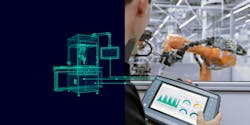How Digital Twins Help Manufacturers Expand Automation Without Replacing Existing Equipment
- Use digital twins to design, test and validate new automation systems virtually, reducing integration time from months to days while minimizing costs and production interruptions.
- Leverage standard robot command interfaces and PLC programming to make robotic systems accessible to shop floor workers, reducing dependence on specific vendors.
- Integrate AI-powered cobots into current production lines to improve flexibility, compensate for labor shortages and maximize efficiency without completely overhauling equipment.
Efficiency in manufacturing is key to ensuring competitiveness for years to come. The challenge is how to achieve efficiency as manufacturers work to tackle labor shortages and successfully integrate new technologies while keeping costs under control. For many organizations the obvious solution would be to further automate their processes, which would guarantee adaptability and operational optimization. But this approach can be intimidating, as many automation solutions require very specific experience and knowledge.
On top of this, many brownfield manufacturing operations prefer to continue in their traditional processes because adopting new systems and integrating more advanced machinery — in addition to hiring personnel with specialized skills — can make it difficult to stay within most manufacturers’ tight profit margins.
That’s why digitalization is the key to modernization and staying profitable. But it’s important to realize that digitalization of manufacturing operations doesn’t mean manufacturers need to scrap all their existing equipment and replace them with new technologies. This reality of digitalization is why the process is often referred to as a digital transformation journey. Start with simulation To guarantee successful integration of new automation features while simplifying the process, manufacturers should leverage simulation to design, off-line program, validate and virtually commission new technologies in a digital twin. This is possible as software can now simulate an entire factory down to the line, station, machine, robot, motors, sensors and actuators — including even the operators working in the factory.
During the design of the workstation in the simulated environment and in the virtual commissioning stages, the cobot operator can accurately see how the cobot will move within the station before anything is built.
Start with simulation
To guarantee successful integration of new automation features while simplifying the process, manufacturers should leverage simulation to design, off-line program, validate and virtually commission new technologies in a digital twin. This is possible as software can now simulate an entire factory down to the line, station, machine, robot, motors, sensors and actuators — including even the operators working in the factory.
Using a digital twin, companies can create an accurate, real-time virtual representation of their factory that is both comprehensible and accessible for workers across teams and disciplines. Knowing where potential modifications fit in will help engineers and designers test how certain processes will work before integrating new machines and processes into a production line. This is an especially important tactic when considering human safety.
With the PLC engineering environment and its low-code programming languages such as ladder logic, it is possible to program a robot by dragging library components into the standard programming environment, enabling shop floor workers to more easily deploy the robot for different tasks.
The full authoring and validation cycle in the digital twin — including the design, programming and virtual commissioning — can significantly reduce the time and effort required to integrate automation systems into existing production lines, democratizing the implementation process for factories with production lines they do not want to interrupt or change. Because testing is done virtually, trial runs of potential new systems are cheap and sustainable, especially compared to physical prototypes. On top of that, simulated verification can be completed within days rather than weeks or months, making it possible to design more optimized and flexible systems very quickly.
Simplify robot programming
Factories with unstructured environments may also have to contend with robots from multiple vendors and their multiple programming methods. Fortunately, leading robot vendors came together to create a standard robot command interface (SRCI), making it possible to use PLC engineering for robot programming. This interface lowers the barrier of using robots in a factory’s automation system.
With the PLC engineering environment and its low-code programming languages such as ladder logic, it is possible to program a robot by dragging library components into the standard programming environment, enabling shop floor workers to more easily deploy the robot for different tasks. This means that service personal can use the same standardized HMI screens for their robotic tasks, independent from the actual robot vendor. As a result, factories no longer need to rely on each specific robot vendor for servicing and, with the right personnel, may even be able to service robotic systems themselves.
Simulated verification can be completed within days rather than weeks or months, making it possible to design more optimized and flexible systems very quickly.
And in conjunction with the digital twin, factories can implement AI to further their robotic automation goals. Using AI, it is possible to improve the industrial robots' sensing capabilities and decision-making processes, further enhancing their functionality. Solutions such as Siemens Simatic Robot Pick AI take advantage of virtual training through digital twin and computer vision technologies to prepare robots to handle unpredictable tasks with over 98% accuracy.
How cobots can help
While automation provides many benefits, some companies are concerned that it may not be worth it because it will require them to completely overhaul their existing production ecosystems. Contrary to popular belief, the path to automation will not require factories to replace every single old machine with newer, more advanced ones. In fact, many factories have seen ROI from integrating collaborative robots (cobots) into their existing production systems.
Using cobots, brownfields can:
- Improve the flexibility and adaptability of their production processes.
- Compensate for a smaller number of personnel as demand for products continues to increase.
- Maximize operational efficiency and lower operational costs.
Most cobots today make use of AI algorithms to achieve more human-like operations that enable some assembly tasks to be automated. For example, some cobots can operate in a standard screwdriving station. Using AI, the cobot can mimic the haptic tactile feedback of a human, allowing it to complete tasks that were once exclusively manual.
The digital twin can also be used to ease the deployment of cobots. During the design of the workstation in the simulated environment and in the virtual commissioning stages, the cobot operator can accurately see how the cobot will move within the station before anything is built. Being able to examine how the cobot and the human worker interact in virtual space is not only less cumbersome than physical prototyping but enables both cobot and operator to work harmoniously from day one.
Rahul Garg is vice president for industrial machinery vertical software strategy, Siemens Digital Industries Software.
More digital twin insights from Automation World:
About the Author
Rahul Garg
Rahul Garg is vice president for industrial machinery vertical software strategy at Siemens Digital Industries Software. As a customer-centric leader, one of his great joys is helping simplify complex problems for customers and enabling success by delivering powerful, effective solutions that support small and mid-sized businesses. Throughout his career having worked at three start-ups and now a large enterprise, Rahul has worked closely with SMBs and in technology-led industries to overcome key challenges and drive revenue growth with strategic solutions, smarter services, and better business practices.

Leaders relevant to this article:

